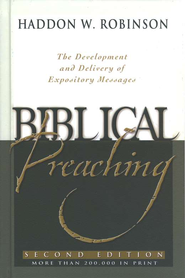
This book review of Hadden W. Robinson’s Biblical Preaching was written as part of Pastor Lane’s doctoral course work, and as such, it is written in a more formal, academic tone than the rest of this blog’s posts. Still, we hope the audience will find these academic book reviews useful, which is why we have published them for your reference.
Haddon W. Robinson is a native of New York City. He received a Th. M. from Dallas Theological Seminary, a M.A. from Southern Methodist University, and a Ph.D. from the University of Illinois. He served as president of Denver Conservative Baptist Seminary for twelve years and taught homiletics at Dallas Theological Seminary for nineteen years. He was instrumental in changing the seminary name to Denver Seminary. In 2007, he became the interim president of Gordon-Conwell Theological seminary. He continues to serve as the Ockenga Distinguished Professor of Preaching and is also senior director of the Doctor of Ministry Program at Gordon-Conwell. He has also served on pastoral staff, staff of para-church organization, and as instructor of speech at the University of Illinois. He was named among Christianity Today International’s Top 25 Most Influential Preachers from 1956-2006, and in an earlier Baylor University poll, as one of the twelve most effective preachers in the English-speaking world. He has authored seven books and written and edited for several magazines. One of his major contributions to homiletics is the Big Idea of Biblical Preaching whereby sermons should have one major idea, even if the big idea breaks down into three subpoints.

The purpose of this book is to teach and train in expositional preaching. This particular book is a second edition with a further purpose though, or a clearer purpose. The author has returned after twenty years of teaching to clarify and refine some of the books content. Without a doubt, this book has been the primer for preaching for over three decades now training preachers in the science and art of the expository sermon. The target of preachers aspiring to be preachers remains. Dr. Robinson is a conservative, evangelical scholar that has a long track record of faithful and influential service, as demonstrated in the biographical information above.
The significant contribution of this book is first that it has been one of the principle training manuals for expository preaching for more than 30 years. Another evident significance of this book is the depth of detail and training for the expository sermon that it gives. There is really no significant aspect of preaching left out from this work. But probably the principle significance of this book for preachers is the level of detail and mastery of thinking about preaching that it provides for the preacher. There is no “stone” left unturned in this book.
The general overview of this book is direct and straightforward. This is a technical book for training. It includes some philosophical issues as they arise, but is not given to this as a primary purpose.
Chapter one establishes “the case for expository preaching.” Dr. Robinson states, “When preachers speak as heralds, they must cry out ‘the Word.’ Anything less cannot legitimately pass for Christian preaching.” And when speaking of the preacher’s temptation to deliver some message other than from scripture, he says, “Yet when they fail to preach the Scriptures, they abandon their authority.” He makes a direct line to the necessity of expository preaching. Following this he offers a definition for working purposes to guide the book. From this definition he offers five areas of focus in the sermon: that the passage is to govern the sermon, the expositor communicates a concept, the concept comes from the text, the concept is applied to the expositor, and the concept is applied to the hearers. This is an excellent chapter that does not entertain unnecessary argumentation with the validity of expository preaching but gets immediately to the purpose for writing, teaching, and training in how to do it, and he creates a clear path to it.
Chapter two introduces the process of developing a sermon with “What’s the Big Idea.” Famous for the concept, Dr. Robinson speaks with great authority on how the sermon must remain one whole, and not a collection of many parts. This is the purpose for the outline, to show how it all interrelates. The purpose is to say that an idea gives the preacher and listener the ability to see and to know the message. The big idea is defined by two elements: the subject and the compliment. These two must always go together and are incomplete without each other.
Chapter three identifies, explores, and discusses tools of the trade. This begins a path toward sermon development. First is to choose a passage to be preached. The basic principle here is to base the sermon on a literary unit of biblical thought. Topical sermons and length are also given some discussion. The study of the passage comes next with consideration of the context. A number of tools for linguistic study, commentary, dictionaries, and encyclopedias are identified to help in this process. The next stage in the process is relating the parts to each other to determine the exegetical idea and its development. Greater explanation for the subject and compliment are given here. This is basic but essential material. I will admit my own difficulty in mastering the concept as he presents it. While I recognize that it’s not that different and I do understand it, I have not been able to really lock in with it in my own practice.
Chapter four is “the road from text to sermon” and presents the fourth stage of the development process: submitting your exegetical idea to three developmental questions. “What does this mean?” is the first and essentially covers the explanation portion. “Is it true?” establishes the validity of the statement and any proof that may be demanded as a result. “What difference does it make?” addresses the application. Following this the author offers a numbers of directions for understanding passages, especially the Old Testament, and several questions to help in discerning how one is using the passage. This portion is most comprehensive and helpful with the resources it offers.
Chapter five is “the arrow and the target.” The fifth stage of development here develops the idea into an exact, memorable sentence. This statement can be more contemporary and less tied to the words of the text. Next comes stage six to determine the purpose for this sermon. This is the purpose for which you expect to happen in your hearers. He is careful to distinguish between the sermon idea and purpose here. This is all very thorough, but again I confess that I have a tendency to get lost and become unclear in the terms, stages, and different aspects of the sermon. In turn, it begins to feel more complicated that I think it should be.
Chapter six considers “the shapes sermons take.” Stage seven is where the homiletical idea takes shape to accomplish the intended purpose. Four different options are offered to develop the sermon: inductive, deductive, inductive-deductive and subject-completed. Stage eight outlines the sermon. This section requires an extensive amount of consideration and feels tedious, maybe an overcomplication. I understand each concept but have typically used different terminology for it.
Chapter seven is about “making dry bones live.” This is where stage nine and filling in the outline with supportive material that explains, proves, applies, or amplifies the points is completed. Here the sermon is completed with restatement of key information, definition and explanation, factual information, quotations, narration, or illustration. Each of these has a special role in the sermon and not all must be equal for every point. But when used correctly this will make the difference between a sermon that is average and one that is exceptional. The author gives great insight as to how and why to use each element. I do believe that preachers will find it more natural in using some of these elements over other ones. This may be due to interests, hobbies, giftings or such, and this doesn’t excuse the intentional use of any of them, but simply that there will be a natural bent toward using some better than others.
Chapter eight says to “start with a bang and quit all over” and includes stage ten of preparing the introduction and conclusion of the sermon. It is important to get the attention of the listener through an introduction. Good introduction may command attention, uncover a need, or address a current topic. It will also introduce the sermon. The conclusion is important as well. It may be by summary, illustration, quotation, question, prayer, or specific direction, but whatever form it may take it should conclude. Be careful not to introduce new material and if at all possible, stop one or two sentences before they expect you to. One cannot give too much thought to the introduction and conclusions. I am a fan of shorter conclusions whenever possible. This chapter is most helpful in bringing a large consideration to two areas of the sermon that too often get overlooked. This information is helpful and insightful.
Chapter nine implores one in “the dress of thought.” Issues such as transitions, style in speaking, personal style, and vividness are included. Advice is offered for a clear outline, short sentences, simple sentence structure, and words. These are issues of the masters in preaching, to state the most complicated of ideas and concepts in the simplest and most direct form possible. This is so hard to accomplish and that is why I think this is probably the most helpful chapter for me. This chapter represents what does not have to be done to make a sermon, but what must be given strong attention if that sermon is to be maximized.
Chapter ten is a primer in “how to preach so people will listen.” Everything is brought together here where the whole is evaluated as one. The finishing touches are placed on the sermon through techniques of communication including grooming and dress, movements and gestures, eye contact, vocal delivery rehearsal and feedback. There is a level of self-awareness and consciousness that is being advised here. This is one of the most difficult measures to press oneself into practicing, but also one of the most rewarding as it matures a communicator. I have learned that it matters how I say something, and even how I introduce a matter, especially if it is a difficult or highly debated passage or topic. The difference between whether people receive it gladly or feel condemned is often as simple as slowing my words, speaking more softly and intentionally, as if to respect them simply through the way I presented the information.
Final matters that conclude the book include answers to exercises and sermon samples and evaluation guides. These are all critical tools to help a preacher excel and hone his edge.
I read this book entirely for this course and have read it a couple other times as well. I always walk away from it encouraged, but with the same feeling that while I love it, I am exhausted from it some of its technical extensiveness. With that said, it is written very well and is in no way difficult to read. I do feel this book accomplishes its purpose exceptionally well.
The concepts that I am most enthusiastic about from this book are first, trying to write sermons outside of my now normal routine and using alternating patterns and forms. I know this is an area where I need help and want to develop my skill here. Second, I want to take more time to give greater emphasis to honing my own preaching through the last two chapters of material and trying to focus on fine-tuning my presentation.
More book reviews by Pastor Lane
